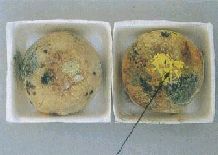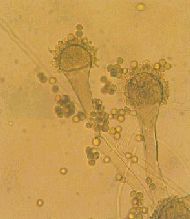Tokyo Food Safety Information Center » Good things to know » Molds and mycotoxins » Eurotium
Eurotium
A mold preferring somewhat dry surroundings (water activity of 0.70 to 0.85) (xerophilic fungus), which often appears on foods with high sugar or salinity concentrations and dry foods including: Japanese and Western cakes, dried seafood products, jams, and tsukudani (food boiled down in soy sauce).
It is a fungus well known for containing bacteria criticized for causing foods to mold. Other than foods, it may gather on camera lenses, films, substrates of fine instruments, and so forth. When it appears on food, it forms colonies that are blue green, or partially yellow as shown in the photo. Eurotium does not produce any highly toxic mycotoxins.
|
Representative strains: Eurotium herbariorum (E.herbariorum) Eurotium amstelodami (E.amstelodami) Eurotium chevalieri (E.chevalieri) |
 Eurotium herbariorum growing on manju cake |
 Photomicrograph of Eurotium amstelodami |